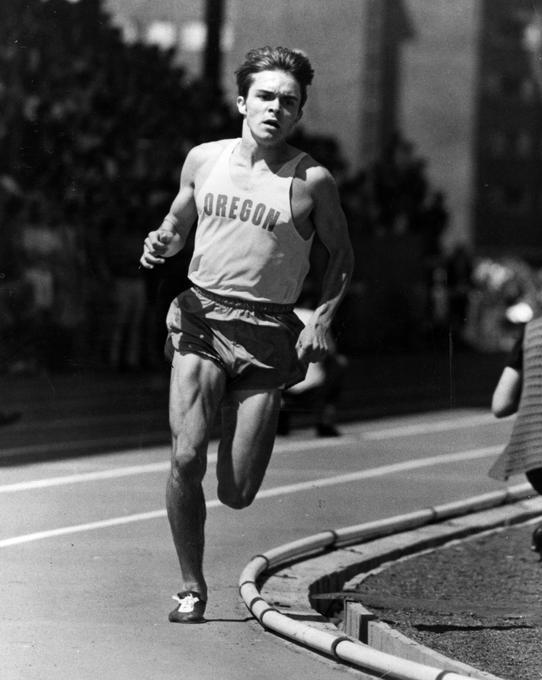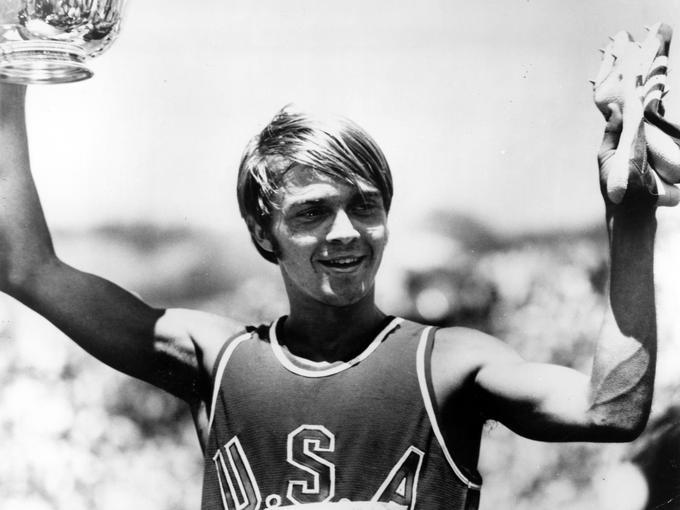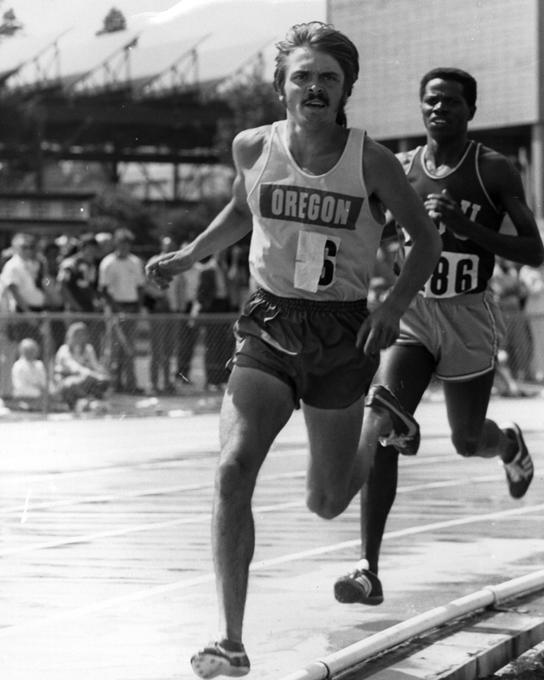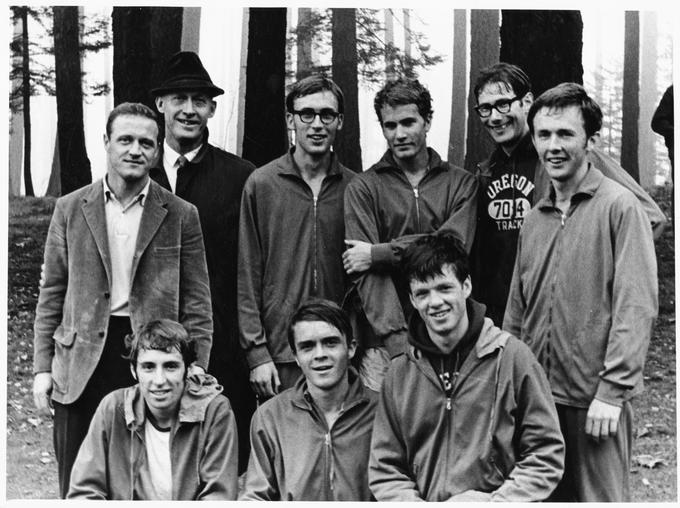For Steve Prefontaine, running was a way to find confidence, a way to stand out and to prove himself. It was also an art form. “Some people create with words or with music or with a brush and paints,” Prefontaine told reporter Don Chapman. “I like to make something beautiful when I run....It's more than just a race, it's style....It's being creative.” Pre, as he was called, helped create a distance-running legacy that reached from the beginning of the running boom in the United States to the birth of Nike. He helped set in motion a movement that solidified the University of Oregon as a mecca of track and field and turned Eugene into Tracktown, USA.
Prefontaine set eight collegiate records while running for the Oregon Ducks and at one time held every American distance running record, from 2,000 meters to 10,000 meters. As his reputation as a competitive runner grew, Prefontaine took on the Amateur Athletic Union, battling the organization over its hold on the lives of athletes. By combining talent with outspokenness, he cut a wide cultural swath that even decades after his death influences distance running worldwide. Prefontaine is in both the National Track & Field Hall of Fame and the Oregon Sports Hall of Fame.
Born in Coos Bay on January 25, 1951, Prefontaine first attracted the notice of the distance-running world while attending Marshfield High School. After showing mild promise during his first two years there, he accumulated a string of victories in his junior year that saw him undefeated for two consecutive years in both cross country and track races. During his senior year, he broke the national high school record for the two-mile run with a time of 8 minutes, 41.5 seconds, during a meet in Corvallis, more than seven seconds faster than the previous record of 8:48.8, set in 1966 by Rick Riley of Spokane.
Prefontaine was recruited to the University of Oregon by assistant coach Bill Dellinger and started running for the Ducks in the fall of 1969 under head coach Bill Bowerman. While at the university, his national reputation grew as he appeared on the covers of Track and Field News (November 1969) and Sports Illustrated (June 15, 1970). He won seven NCAA titles (track and cross country combined) and was undefeated in any race longer than one mile.
When he was twenty-one years old, Prefontaine competed in the 1972 Munich Olympics and led the pack for a time in the 5,000-meter event before falling back in the last 200 meters. He finished fourth and was considered a top contender for the 1976 Olympics.
At about the same time, Prefontaine began to openly express his frustration with the Amateur Athletic Union, the governing body of track and field, which prohibited its members from giving endorsements or taking money to perform. Prefontaine joined others in pointing out the hypocrisy of a situation in which the organization made millions of dollars from events but allowed athletes nothing in the way of payment. In 1973, Prefontaine signed with Nike, for $5,000. In 1978, three years after Pre died, President Jimmy Carter signed the Amateur Sports Act, which ended the AAU’s hold on track and field and advanced many of the goals that the runner had advocated.
An ambassador for his sport, Prefontaine organized a five-stop tour in the spring of 1975 that featured a group of Finnish athletes who would compete in a series of meets to capitalize on the running boom. The last stop on the tour was an NCAA preparatory meet at the University of Oregon on May 29. Prefontaine won the 5,000 in 13 minutes, 23.8 seconds.
After the meet, Prefontaine went to a party with the Finns, girlfriend Nancy Alleman, marathoner Frank Shorter, and others. According to the Register-Guard, he left the party in his orange MGB convertible at about 12:15 am. After dropping off Alleman and Shorter, Prefontaine headed toward Skyline Boulevard, where his car struck a boulder alongside the road, flipped, and came to rest on top of him. He died before the car could be moved. There remain questions about whether Prefontaine’s drinking that night contributed to the crash, but there is no debate about his legacy.
In 2013, in an attempt to explain why Prefontaine remains influential decades after his death, Doug Wilson of ESPN.com talked to Steve Bence, a teammate and friend of the dynamic distance runner. Pre always competed hard, almost urgently, Bence said, whether he was on the track or simply living his life. ”It wasn't so much about what he did or his times or his place,” Bence told Wilson. “It was how he went about competing and living his life that inspired people.”
A network of running trails in Eugene is named after Prefontaine, as is the Prefontaine Classic, an annual track and field meet held at the University of Oregon, and a building at Nike headquarters in Beaverton. Three films have been made about him: Prefontaine: Fire on the Track (1995), a documentary, and feature films Prefontaine (1997) and Without Limits (1998). The Coos Bay Art Museum has a Pre section, and Prefontaine’s hometown hosts an annual Prefontaine Memorial Run (10K). The Marshfield High School track is dedicated to him.
-
![]()
Steve Prefontaine, 1970.
Courtesy University of Oregon Libraries, A_ATHPRE0006rb
-
![]()
Steve Prefontaine, 1971.
Courtesy University of Oregon Libraries, A_ATHPRE0004rb
-
![]()
Steve Prefontaine, 1973.
Courtesy University of Oregon Libraries, A_ATHPRE0012rb
-
![Back: Bill Dellinger, Bill Bowerman, Mike Lyons, Mike McClendon, Norm Trerise, Terry Dooley; Front: Tom Morrow, Prefontaine, Steve Savage]()
University of Oregon cross country team, 1969.
Back: Bill Dellinger, Bill Bowerman, Mike Lyons, Mike McClendon, Norm Trerise, Terry Dooley; Front: Tom Morrow, Prefontaine, Steve Savage Courtesy University of Oregon Libraries, A_ATHTF_CCMens_0025sg
-
![Located at the site of Prefontaine's death.]()
Pre's Rock memorial, 2009 (dedicated in 1997).
Located at the site of Prefontaine's death. Courtesy University of Oregon Libraries, photo by Dean Walton
Related Entries
-
![Eugene]()
Eugene
Eugene is a metropolitan center at the head of the Willamette Valley, a…
-
![Rudy Chapa (1957-)]()
Rudy Chapa (1957-)
“Rudy, Rudy,” chanted the fans attending the June 1978 NCAA Track and F…
Map This on the Oregon History WayFinder
The Oregon History Wayfinder is an interactive map that identifies significant places, people, and events in Oregon history.
Further Reading
Jordan, Tom. “Pre: The Story of America's Greatest Running Legend, Steve Prefontaine.” Emmaus, PA: Rodale Books, 1997.
Moore, Kenny. "Bowerman and the Men of Oregon." Emmaus, PA: Rodale Books, 2007.
Heald, Michael. “Why Pre still matters.” Runner’s World magazine (March 22, 2013).







